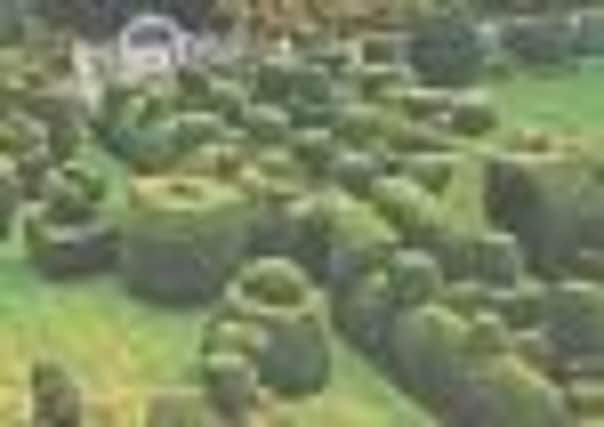Gardens: Restoring a historic garden to its former clipped glory involved detective work


From this west-facing vantage point in the Long Gallery there is a breathtaking view over the stands of yew topiary that shape the walled garden below. Closer inspection reveals that the apparent random scattering of the chunky raised cones, pyramids, spirals, arches, domes and cubes are laid out in the shape of four Saltires, with one at each corner of the garden.
To the right, a long hedge, punctuated with squares, cubes and cones, hides a second more densely planted space where giant topiary squares and rectangles are topped with inverted shapes – rounded like pudding basins – in a variety of sizes.
Advertisement
Hide AdAdvertisement
Hide AdThe evocative scene combines a thrilling trio of Scottish history, architecture and landscape design, exuding a timeless quality that remains fresh over a century after the topiary – much of which is now 245 years old – was moved here from a derelict Edinburgh garden.
Built in 1546 by Sir William Bruce, the castle was later bought by the Perthshire merchant Robert Mackenzie, who commissioned the 26-year-old architect Robert Lorimer to restore the castle and lay out the garden. It was Lorimer’s first commission, although he had already designed the garden at his family home, Kellie Castle.
Much as he had at Kellie, Lorimer embraced the Scottish baronial style, avoiding the late 19th-century vogue for incorporating Victorian additions to buildings. “Mackenzie saw Kellie and commissioned Lorimer to build the castle, the gatehouse and the garden,” Paul explains.
Sadly, by the time Dutch-born Paul and Josine bought the castle its contents and books had disappeared along with the garden plans. “We had to start afresh,” Paul says. “I got in touch with an antique book seller and said I wanted to buy anything that mentioned Earlshall.”
The real breakthrough came with the discovery of Formal Gardens in England and Scotland by H Inigo Riggs, published in 1902, which contained a reproduction of Lorimer’s original plan for the three-acre garden; a find that transformed the restoration project.
The outer garden is entered via a wooden door set in the vast oak gate incorporated into the gatehouse. From here the castle rises up above a paved area, with the Union flag laid out with cobble setts and stone flagstones, before opening into a wide avenue of pollarded lime trees. The red-tinged suckers that sprout from the base of the trees have been allowed to remain, adding a brilliant flash of red into the autumn palette. “In summer the trees appear to float on a sea of green,” says Paul.
An informal, rural note is emphasised by the cattle grazing in the field opposite, while in the spring the scene is transformed by the glorious colour of 9,000 tulips planted in the rows of tubs lining the paved drive. Year-round there are charming walks in the established woodlands that surround the castle.
Closer in, to the north, a vegetable parterre, roughly the size of a tennis court, has been divided, following Lorimer’s original plan, into four different areas separated by brick and stone paths. Espaliered apple trees imported from Holland line three quarters of the space with the sunny, south-facing walls reserved for peaches and plums.
Advertisement
Hide AdAdvertisement
Hide AdIt is while exploring this garden that you begin to partially understand the skills that Lorimer bought to the project: at Earlshall, as at Kellie, Lorimer incorporated a central axis, linking the vegetable parterre to the croquet lawn. This is just one of the many axes that cross the walled garden, emphasising views and vistas, uniting focal points such as benches or arches, imposing order on what at first glance appears to be a random layout of topiary shapes. Just how Lorimer achieved this sense of perfection remains, for Paul, a matter of wonder. “Every time I walk through the garden I am overwhelmed by the way in which it has been designed and developed.”
The shapes are clipped and shaped annually, although sometimes a more drastic cut is necessary on yew that has outgrown its allotted space or become congested. “If you have the right team in place maintenance is not a problem,” adds Paul, alluding to head gardener Nicky McIntyre, who took over from the late Henry Colliar, the renowned gardener who dedicated 68 years of service to Earlshall. Nicky now works mostly alone with extra maintenance help.
In summer and late autumn the croquet lawn, furnished by a summerhouse in the corner, offers an informal contrast to the topiary in the shape of colourful herbaceous borders, the vibrancy of which Paul attributes to “the fantastic mild climate”. Roses also grow well here, with Rosa rugosa in a double herbaceous border; there is also a formal rose garden.
To their surprise the Veenhuijzens uncovered a secret garden behind Dummy Daws, the dwelling incorporated into the courtyard. Also reached from a small gate in the outside wall, it has been restored to its original box layout. “We dug out a little pond, which is now filled with lilies,” Paul says.
Other intriguing details, such as wrought iron grills, stone urns, tiny stained-glass windows and a group of stone monkeys, are scattered around.
Energetic and enthusiastic, Paul and Josine are perfect owners for this historic, well-maintained garden. “For me it is the diversity that is the best thing about this garden,” Paul says. Besides the topiary, the vegetable garden, the herb garden, fruit trees and the rose garden and the lawns, there are still surprises waiting to be discovered. “We were recently told that there is a sculptured head of Lorimer hidden behind a little panel within a wooden bedroom door. This is now called Lorimer’s room.”
Earlshall Castle, Leuchars, Fife, tel: 01334 839205, email [email protected] Private bookings include lunch and a tour of the house and garden. Earlshall Castle and Gardens are open under Scotland’s Gardens Scheme on 29 May and 3 July 2012, www.gardensofscotland.org; Kellie Castle, www.nts.org.uk